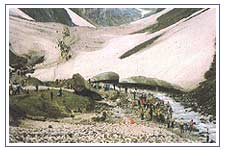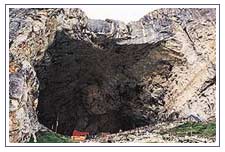
One
of the holy Trinity, Shiva is a living God. The most sacred and the most
ancient book of India, the 'Rig Veda" evokes his presence in its hymns.
Vedic myths, rituals and even astronomy testify to his existence from the
dawn of time. But Shiva, Destroyer, the mendicant, is indefinable.
The Yatra
(pilgrimage) on foot to Amarnath Cave, considered one of the holiest
naturally occurring shrines of the Hindu faith, has continued annually for
little more than a hundred years. Extending up 130 feet, the Amarnath Cave
is high and shallow.
A Linga Of Ice
Inside the large opening, behind an open-gated iron fence, an underground
trickle of water emerges 10 feet up from a small cleft in the sedimentary
rock and freezes s it drips to form a small cleft in the sedimentary rock
and freezes as it drips to form a tall, smooth cone of ice.
Legends of Amarnath
Kashmir - An Ancient Shaivaite Centre
According to the legend, Shiva made the Gods immortal by providing them
with the celestial nectar, and resided here upon their request. This boon of
immortality lent the name Amarnath.
Kashmir was a great Shaivite center in the 1st millennium CE. Kashmiri
Shaivism is referred to as "Trika Mata" and it dates back to the
8th century CE. The three components of Kashmiri Shaiva literature are "Agama
Shastra", "Spanda Shastra" and the "Pratyabhijna Shastra".
"Kalhana", a contemporary of King Jayasimha of Kashmir of the 12th
century describes Kashmir as Parvati incarnate. Legend has it that there was
once a lake by name Sati-Saras named after Shiva's consort Sati. Sage
Kashyapa, the grandson of Bhrama, destroyed the demons residing over here.
It is believed that Kashyapa then converted this lake into "Kashmira
Mandala".
Tales Of the Cave Discovery

Legend
has it that Lord Shiva recounted to Goddess Parvati the secret of creation
in a cave in Amarnath. Unknown to them a pair of mating doves eavesdropped
on this conversation and having learned the secret, are reborn again and
again, and have made the cave their eternal abode. Many pilgrims report
seeing the doves pair when they trek the arduous route to pay obeisance
before the ice-lingam.
According to an ancient tale, there was once a Muslim Shepherd named Buta
Malik who was given a sack of coal by a Sadhu (saint). Upon reaching home he
discovered that the sack, in fact, contained Gold. Overjoyed and overcome,
Buta Malik rushed back to look for Sadhu and thank him. But on the spot of
their meeting discovered a cave, and eventually this became a place of
pilgrimage for all believers. To date, a percentage of the donations made by
pilgrims are given to the descendents of Malik, and the remaining to trust
which manages the shrine.
Yet, another legend has it that when Kashyap Rishi drained the Kashmir
valley of water the cave and lingam were discovered by Bregeish Rishi who
was travelling the Himalayas. When people heard of lingam Amarnath for them
it became Shiva's abode and a centre of pilgrimage.
Getting Away
Road:
From Baltal there is a regular bus service during the pilgrimage period,
getting back to Srinagar that night. At other times, camp at Baltal and
continue to Sonamarg at a more leisurely pace the following morning. From
Sonamarg there are three buses a day to Srinagar and the drive takes around
five hours.
Do's and Don'ts for Pilgrims
Yatries without registration card, Aged, infirm, ailing and ill clad
persons will not be allowed to proceed beyond Pahalgam and Baltal.
WARNING: At the present time this is a very dangerous area and it is
highly advised that foreign tourists do not go here because of Kashmiri
militants. It is best to check the situation in advance.


 One
of the holy Trinity, Shiva is a living God. The most sacred and the most
ancient book of India, the 'Rig Veda" evokes his presence in its hymns.
Vedic myths, rituals and even astronomy testify to his existence from the
dawn of time. But Shiva, Destroyer, the mendicant, is indefinable.
One
of the holy Trinity, Shiva is a living God. The most sacred and the most
ancient book of India, the 'Rig Veda" evokes his presence in its hymns.
Vedic myths, rituals and even astronomy testify to his existence from the
dawn of time. But Shiva, Destroyer, the mendicant, is indefinable.  Legend
has it that Lord Shiva recounted to Goddess Parvati the secret of creation
in a cave in Amarnath. Unknown to them a pair of mating doves eavesdropped
on this conversation and having learned the secret, are reborn again and
again, and have made the cave their eternal abode. Many pilgrims report
seeing the doves pair when they trek the arduous route to pay obeisance
before the ice-lingam.
Legend
has it that Lord Shiva recounted to Goddess Parvati the secret of creation
in a cave in Amarnath. Unknown to them a pair of mating doves eavesdropped
on this conversation and having learned the secret, are reborn again and
again, and have made the cave their eternal abode. Many pilgrims report
seeing the doves pair when they trek the arduous route to pay obeisance
before the ice-lingam.